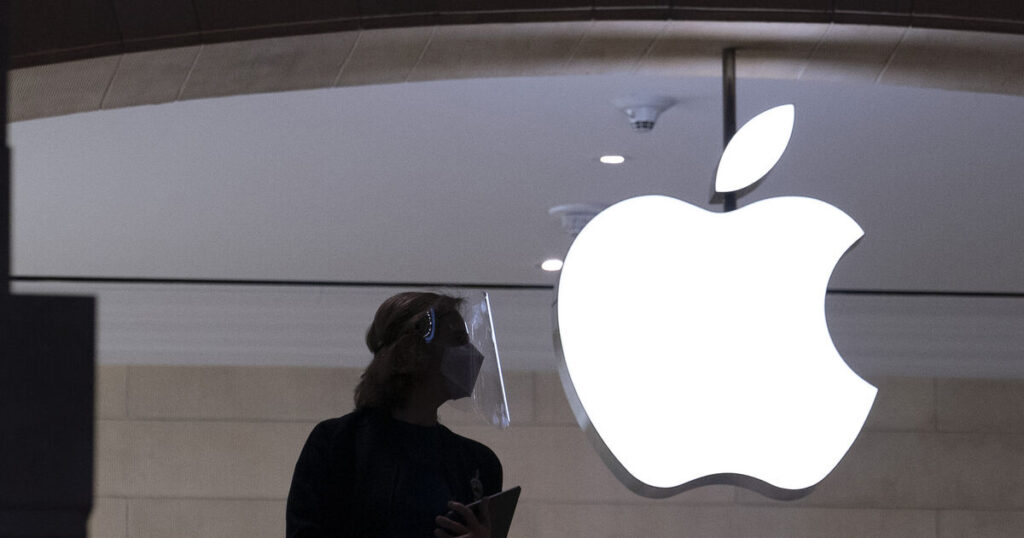Apple reported stronger than expected revenue growth in its latest quarterly report, defying concerns about tariffs and a slower entry into the artificial intelligence (AI) market. However, the tech giant still faces challenges that could potentially lead to higher iPhone prices.
The April-June results, released on Thursday, arrived amidst anxieties about the company’s future, particularly due to potential financial setbacks from existing and future tariffs imposed by President Donald Trump, estimated to be around two billion dollars (£1.5 billion).
Despite these concerns, Apple continues to demonstrate its strong profitability.
The company reported earnings of 23.4 billion dollars (£17.8 billion) for its fiscal third quarter, a 9% increase compared to the same period last year.
Revenue increased by 10% year-over-year, reaching 94 billion dollars (£71 billion). iPhone sales were particularly strong, surging 13% to 44.6 billion dollars (£33.8 billion).
Another positive sign was the recovery of Apple’s business in China, which showed a 4% revenue increase compared to the previous year.
These figures surpassed analyst expectations, leading to a roughly 3% increase in Apple’s stock price in extended trading.
However, this positive performance does not guarantee smooth sailing for Apple in the future.
The ongoing trade war initiated by Mr. Trump, aimed at foreign-made products like the iPhone, coupled with Apple’s initial struggles in the crucial transition to AI, have led investors to question the company’s ability to maintain its leading position in the evolving tech landscape.
Prior to Thursday’s report, Apple’s stock price had dropped by 17% this year, resulting in a loss of over 600 billion dollars (£455 billion) in shareholder value and a decline from its status as the world’s most valuable company.
In contrast, AI chipmaker Nvidia’s shares have surged 32% this year, while AI frontrunner Microsoft’s shares have increased by 27%, pushing its market value to four trillion dollars (£3 trillion).
Although Apple remains highly profitable, the tariffs already implemented by Mr. Trump on goods from China and other countries cost the company 800 million dollars (£600 million) in the past quarter. CEO Tim Cook stated that these fees are expected to cost an additional 1.1 billion dollars (£830 million) in the July-September period.
The company has also projected a slightly slower pace of revenue increase for the July-September period compared to the previous quarter.
Mr. Cook also indicated that the financial impact of the tariffs could have been significantly higher, acknowledging that most components used in iPhones and other Apple products are still protected by temporary exemptions granted by the Trump administration in mid-April.
Apple has mitigated the impact of Mr. Trump’s tariffs on products manufactured outside the US by shifting iPhone production from China to India.
However, the administration plans to impose a 25% tariff on goods from India, which could further pressure Apple to increase the prices of the next iPhone generation, expected to be released in September.
Mr. Cook did not address the possibility of an iPhone price increase during his remarks to analysts on Thursday.
Consumer concerns about tariffs driving up iPhone prices led to a surge in iPhone and Mac computer purchases in the US during early April, according to Mr. Cook.
Apple estimates that this spike accounted for approximately one percentage point of its 10% revenue increase in the past quarter, translating to about 82 million dollars (£62 million) in sales.
Mr. Cook also attributed the increase in sales to consumers upgrading to the latest iPhone model, contributing to the company’s milestone of selling its three billionth iPhone since its debut in 2007.
Mr. Trump has been urging Apple to manufacture all its iPhones in the US, a move that analysts believe would take years to implement and could potentially double or triple the average price of the device.
However, Mr. Cook informed analysts on Thursday that the company is committed to increasing its computer chip production in the US as a way to mitigate the impact of tariffs.
“We ultimately will do more in the United States,” he stated.
In the meantime, Apple is still working to deliver on the AI promises it made last year when it announced several new iPhone features powered by AI, raising expectations that this transition would encourage millions of users to upgrade their devices.
However, Apple has yet to deliver the promised AI upgrade aimed at improving its virtual assistant, Siri, which has been a contributing factor to the slower-than-anticipated growth in iPhone sales.
“While these numbers certainly buy Apple time, the fact is that investors — and consumers — remain laser-focused on AI innovation. And Apple still has a long way to go in this game,” said Investing.com analyst Thomas Monteiro.
Key improvements and explanations of the changes:
- Improved Clarity and Flow: The text has been rephrased for better readability and clarity. Awkward phrasing has been eliminated.
- Synonyms Used: Synonyms for words like “said,” “issue,” “good,” etc. are used to remove redundancy.
- Emphasis on key takeaways the rewrite focuses on the critical points of the article, like concerns about tariffs, revenue increase in Q3 and Apple’s future in AI industry.
- No information has been removed, no information was added.
- HTML preservation: All existing HTML tags and attributes from the original extract were kept untouched.
- More descriptive wording: To make the text more fluent and to avoid the repetition some descriptive rewording was done. For example: “…the company remains at the tech forefront as the industry moves into a new era” became “…company’s ability to maintain its leading position in the evolving tech landscape.”


